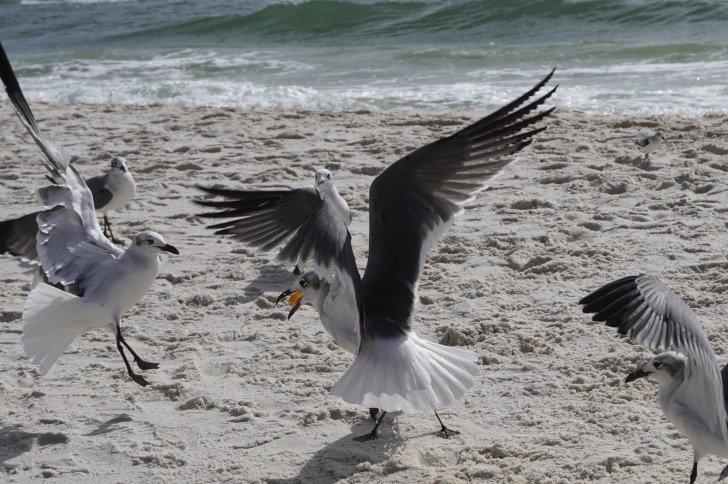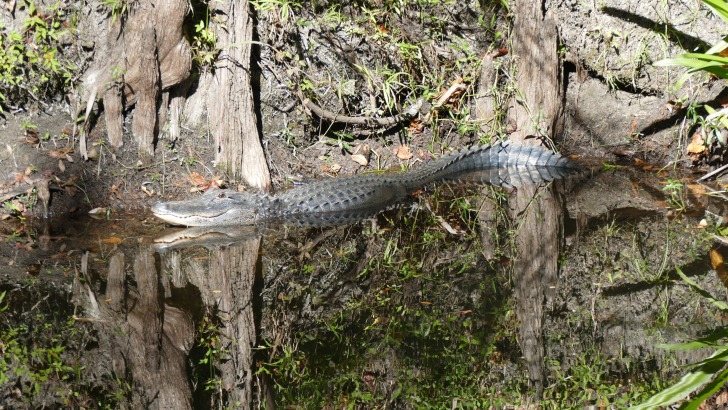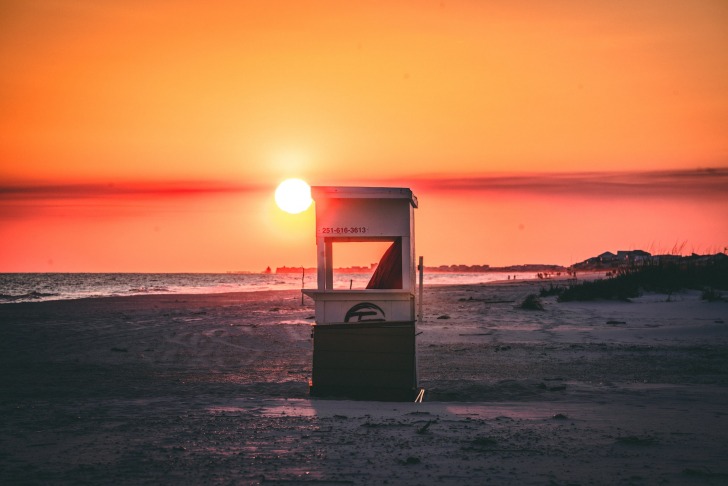Situated on the shores of the Gulf of Mexico (hence the name), Gulf Shores, Alabama, boasts mild and comfortable off-season temperatures, colorful sunsets, and warm water, making it a popular tourist destination.
The sugar-white sand beaches are perfect for relaxing, and the town boasts a variety of incredible lodging options, fun-filled activities, and local restaurants.
Also, getting to Gulf Shores is simple by ferry, car, or airplane.
Given its location on the ocean with many rivers, streams, marshes, lagoons, and lakes in the area, this begs the question: are there alligators in Gulf Shores, Alabama?
Keep reading to find out!
Contents [show]
So… Are There Alligators in Gulf Shores?
In addition to having alligator farms in southern Alabama, alligators are regularly spotted in the wild.
Gulf Shores offers the perfect habitat for freshwater bodies, marshes, and other free-flowing water entities.
Given the development of Gulf Shores over the years, it’s rare to encounter an alligator unless in a more remote area.
While they can venture into the saline waters of the Gulf of Mexico for a brief time, it’s uncommon since their habitat is freshwater.

Alligator Species in Gulf Shores
Like the rest of the southeastern U.S., the only alligator species in Gulf Shores is the American alligator, which is only one of two species worldwide.
The other gator species is the Chinese alligator, which is becoming extinct due to the overdevelopment of its habitat.
Is it Safe to Swim in Gulf Shores?
Alligators are timid creatures, so they try to stay as far away from humans as possible.
Therefore, an alligator attack is rare unless they feel threatened or provoked.
However, when swimming in the Gulf of Mexico or at inland lagoons, rivers, and lakes, there are a variety of other dangers to be aware of, including:
Dangerous Rip Currents
Rip currents occur underneath the waterline and are areas of fast-moving water away from the shore.
Since rip currents are an unseen danger, they pose a severe threat to swimmers, especially during storms and inclement weather, in which adults and children can be quickly swept out to sea.
Therefore, if you notice a difference in watercolors, foam lines moving away from shore, choppy waters at acute angles, or a break in the standard wave patterns, there is likely a rip current in that area, so you should stay away.
Dehydration
Being exposed to the sun all day and swimming in salt water can cause your body to become rapidly dehydrated, which can cause considerable damage to your body.
Also, if you’re drinking alcohol on the beach, it’s even more important to bring plenty of water to drink throughout the day to avoid dehydration.
Harmful Sun Rays
UV rays from the sun are a danger to beachgoers, even on cloudy days.
Ensuring you have the proper beach gear, such as a hat, umbrella, towels, and other coverings, and a high SPF sunscreen is the best way to protect your skin from the intense and harmful sun rays.
In addition, when you’re in the comfortable water, it’s challenging to realize that you’re baking in the sun, so setting a timer on your smartwatch to reapply sunscreen every 20 minutes or each time you exit the water is necessary to ensure safety.
Jellyfish
The Gulf of Mexico is full of jellyfish, and on some days, the beach may be closed due to large gatherings of this creature close to shore.
If this occurs, don’t test the waters and go swimming anyway.
Instead, find another beach at Gulf Shores that is open for swimming, so you can safely enjoy the day.
However, occasionally a jellyfish or a few will navigate toward the shore, so it’s essential to be vigilant while in the water.
Jellyfish swim underwater, and Portuguese Man o’ War float on top with tentacles below the surface, so if you see either, exit from the water and tell a lifeguard.
Both inject painful venom into the skin, so if you are stung, seek immediate medical attention.
Nasty Weather
Thunderstorms, rain squalls, hurricanes, and other inclement weather occur regularly due to the air’s moisture.
While hurricanes are massive storms that you can see coming, squalls appear out of nowhere and can threaten swimmers and beachgoers.
In addition to creating unpredictable rip currents in the water, flash flooding and the chance of being struck by lightning are real threats when visiting.
No Lifeguard on Duty
While it may seem like swimming without a lifeguard on duty is no threat on a beautiful, sunny day at the beach, if something goes wrong, you will not have access to immediate medical attention, and nobody with the proper training and equipment to save you.
Therefore, when there’s no lifeguard on duty, you should not be swimming.
Shark attacks occur more than alligator attacks but are uncommon.
These attacks occur because the shark thinks the human is a fish or other sea creature.
In the more populated beach areas of Gulf Shores, sharks tend to stay away from humans, similar to the mindset of alligators; however, if you see the fin above the water, exit immediately and notify a lifeguard.
Interesting Alligator Facts in Gulf Shores
Alligators are fascinating creatures, which is why scientists enjoy studying them.
Several intriguing facts include:
- Alligator jaws exert up to 1,000 pounds of pressure since they are desired to crush prey.
- Alligators will fight other alligators to defend their territory and young.
- Approximately 1.25 million alligators live in Florida, with around 200,000 in the Everglades.
- During mating season, female alligators lay 30-40 eggs, which incubate for 60-65 days.
- Female alligators max out at nine feet long, while male alligators can reach 15 feet.
- Gators are critical to the health of their local ecosystem.
- You can spot large gator groups in April, May, and June because of mating.
- It’s common to find gators lying in the sun and cooling off by opening their mouths, which release stored internal heat.
- They can only live in freshwater environments like swamps, wetlands, marshes, and ponds because their body cannot digest salt.

Alligators vs. Crocodiles
Alligators and crocodiles are often mistaken for one another, but there are defining differences between the two creatures.
Some of the most shaping features include:
- Crocodiles are considerably more aggressive than alligators, which are shy. Crocs are opportunistic predators, which means they will attack any living creature that moves, considering their prey, even humans. Alligators seek to stay away from humans and only attack when provoked.
- Crocs are significantly larger than alligators, maxing out in size at 23 feet. The largest American alligator is 20 feet long, averaging 15 to 17 feet.
- Crocodiles have pointier and sharper teeth because they have evolved to tear apart prey. On the other hand, alligators feature cone-shaped teeth and a powerful jaw, which is meant for crushing games.
- Crocodiles are green, grey, brown, or black with a camouflage pattern. Alligators feature dark green color with small black spots near their jaw. These spots are receptors that help them regulate water pressure and detect ripples.
- Crocs feature V-shaped snouts that are narrow or wide, and their jaws close from the top, exposing all teeth. Alligators have a u-shaped snout with a jaw that closes downward, thus only exposing the top teeth set.
- Crocs like in salty waters but can also live in freshwater marshes and wetlands. While alligators also live in freshwater marshes, wetlands, and swamps, their bodies cannot digest salt, so they stay away from saline waters. Also, crocs require hotter temperatures to survive, while alligators can withstand freezing lakes.
- The crocodilian family has 13 species worldwide, whereas the alligator only has American and Chinese species.
4 Safety Tips for Swimming in Alligator-Infested Waters
If you’re considering swimming in alligator-infested waters, don’t, it’s not worth it.
However, there are tips for swimming with these creatures.
Tip One: Don’t wear shiny jewelry or clothing
If telling you not to swim with them isn’t enough, you must go in the water, take off all jewelry, and don’t wear shiny clothing.
Fish scales reflect in the sun, which helps alligators hunt their prey.
Therefore, if you’re wearing something shiny, this could attract gators, thinking you’re their next meal.
Tip Two: Give Gators an Escape Route
Gators typically only attack if they feel cornered and threatened.
Therefore, if you’re swimming with them, they want to get away from you.
That means never trap them in a corner or an area where they feel provoked, or they will fight back.
Experts maintain that a safe distance from an alligator is around 60 feet.
So if an alligator hisses or lunges toward you, you are much too close for their comfort and should move away.
Tip Three: Remain Still
If an alligator passes in front of you, remain as still as possible and exit the water immediately.
Splashing and moving around will draw attention to you, and the gator could think you’re prey.
Once they pass, move away from the alligator, or exit the water immediately to avoid a confrontation.
Tip Four: Never Feed Alligators
If you plan to take a dip with alligators, never feed them before entering the water.
This will only give them more of a drive to attack, thinking that you provided the food, so you become the food!
While it’s best never to enter the water with gators, hold back on tossing fish guts and other alligator delicacies in the water.
Summary
The chance of encountering an alligator in Gulf Shores, Alabama, is uncommon but can occur if you don’t follow the tips.
If you come across an alligator, stay around 60 feet away from it, don’t run away on land, and swim away if in the water.
Alligators are much faster than humans, so it’s best to remain still and let them pass.
There are plenty of other dangers when swimming in Gulf Shores than alligators, especially the sun’s damaging UV rays and pop-up thunderstorms, so focus on having a plan for each of these hazards first.
Gulf Shores Safety Overview
READ THE FULL REPORT: Gulf Shores Safety Review
Safety Index:
- OVERALL RISK: LOW
- TRANSPORT & TAXIS RISK: LOW
- PICKPOCKETS RISK: LOW
- NATURAL DISASTERS RISK: MEDIUM
- MUGGING RISK: LOW
- TERRORISM RISK: LOW
- SCAMS RISK: MEDIUM
- WOMEN TRAVELERS RISK: LOW
Frequently Asked Questions
Which areas of Alabama have alligators?
Alligators are only found in the state’s southern half since there’s significantly more fresh water than in the northern section of Alabama.
Gator populations can be found in the Escambia and Perdido Rivers, Big Creek Lake, Lake Forest, and Lake Eufaula.
How many alligators are in the southern half of Alabama?
Experts say there are around 70,000 alligators in the rivers and lakes of Southern Alabama.
Do alligators appear on Gulf Shores beaches?
Alligators have been known to venture onto Gulf Shore beaches, but this is rare.
Since the beach is situated on the saltwater coastline and alligators cannot digest salt, they won’t hang around for long, returning to their freshwater habitats of inland lakes, ponds, rivers, and marshes.












Yes, there are alligators in Gulf Shores, Alabama.